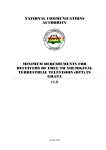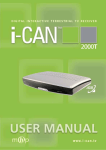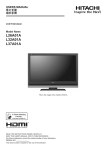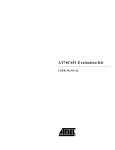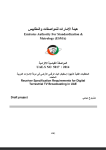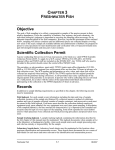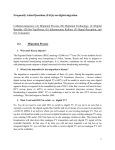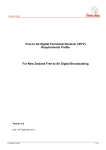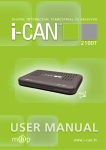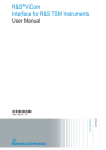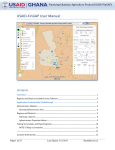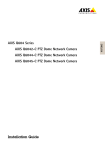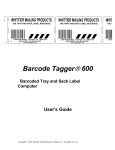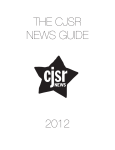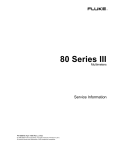Download Draft Minimum Requirements for FTA Digital Television Receivers
Transcript
NATIONAL COMMUNICATIONS AUTHORITY MINIMUM REQUIREMENTS FOR RECEIVERS OF FREE TO AIR DIGITAL TERRESTRIAL TELEVISION (DTT) IN GHANA INVITATION FOR COMMENT i May 2012 INVITATION FOR COMMENT 1. The NATIONAL COMMUNICATIONS AUTHORITY (NCA) is mandated by Section 2 of the Electronic Communications Act, 2008, Act 775 to regulate the radio spectrum designated or allocated for use by broadcasting organisations and providers of broadcasting services in accordance with the standards and requirements of the International Telecommunications Union and its Radio Regulations as agreed to or adopted by the Republic. In furtherance of carrying out this function the law mandates the Authority to determine technical and other standards and issue guidelines for the operation of broadcasting organisations and bodies providing broadcasting services. 2. In pursuance of the above mandate, the National Communications Authority in conformance to the Geneva, 2006 (GE06) Agreement is carrying out a transition of television broadcasting services in the frequency bands 174–230 MHz and 470–862 MHz from analogue to digital technology. 3. Digital terrestrial television (DTT) offers improved spectrum efficiency compared to analogue TV. It also offers enhanced video and audio quality, interactivity, as well as increased programme choices. 4. The Authority is mandated by Section 3(a) of the National Communications Authority Act, 2008, Act 769 to establish and monitor the implementation of national communications standards and ensure compliance accordingly. The Authority has therefore established the following standards for Digital Terrestrial Television (DTT) in Ghana: a. Transmission standard - ETSI EN 302 755 popularly called DVB-T2 b. Compression technology – Advanced Video Coding (AVC)/MPEG-4 (part 10) and High Efficiency Advanced Audio Coding (HE-AAC) c. Application Programming Interface (API) for additional and interactive services MHEG-5 5. During the digital television transition, viewers would require TV sets with the capability of receiving digital television signals transmitted according to the standards above. ii Figure 1: Reception of Free to Air digital signals using integrated digital TV set 6. Viewers whose TV sets are able to receive only analogue signals will need to use special digital adapters, i.e. set-top boxes, which have the primary function of converting digital input to analogue output signals. Figure 2: Reception of Digital TV signals using analogue TV Set and a set top box 7. Viewers who may have integrated digital sets based on DVB-T/MPEG-2 or DVBT/MPEG 4 standard would not be conforming to the Ghana standard (DVB-T2/MPEG-4) and would also need a standard set-top box. 8. The Authority considers that the majority of Ghanaians would convert their existing analogue TV sets to receive digital television transmissions through the use of set top boxes (STBs) and shall therefore take the necessary steps to protect consumers from subiii standard products in accordance with Section 5(c) of the National Communications Authority Act, 2008, Act 769. 9. Further, the Authority is mandated by Section 66 of the Electronic Communications Act, 2008, Act 775 to certify terminal equipment of public electronic communications network. 10. In pursuance of this mandate, the Authority intends to publish standards for digital terrestrial television receivers (set-top boxes, integrated digital television sets, etc) to ensure that, all DTT receivers sold on the Ghanaian market conform to the minimum receiver standard. 11. The Authority shall upon publication of the minimum receiver standard, define a conformance regime and shall require all STBs and integrated digital TV sets sold in Ghana to pass a conformance test to be certified. 12. A logo, known as the 'digital Ghana thumb' (see Figure 3), has been developed as a certification mark to help consumers and retailers through switchover in Ghana. The 'digital Ghana thumb' logo shall be featured in marketing campaigns related to the transition from analogue to digital broadcasting, and consumers of Digital Terrestrial Television (DTT) services shall be told to “look for the logo" when buying digital TV equipment. The logo is designed to identify digital TV products and digital TV services that have been tested and found to conform to Ghana’s technical specifications. Figure 3: Digital Ghana Thumb Logo indicating conformance of STBs to Ghana's minimum requirements 13. In pursuance of the Authority’s mandate under section 27 of the Electronic Communications Act, 2008, Act 775 and Section 4.1 of the National Telecommunications Policy 2005 (NTP’05), the Authority hereby invites views and comments from Existing and Prospective Broadcasting industry players; consumers of broadcasting and communications services and the General Public on the Draft Minimum Requirements for FTA Digital Television Receivers. 14. The Draft Minimum Requirements for FTA Digital Television Receivers can be accessed on the Authority’s website, www.nca.org.gh. iv 15. The public consultation begins with immediate effect and shall expire on 5pm on 25th May, 2012. 16. All responses/comments should be electronically transmitted as e-mail attachments, in Microsoft Word format to [email protected]. 17. All respondents are requested to complete a response cover sheet (see Page vi below). The cover sheet and response template can be downloaded on the Authority’s website, www.nca.org.gh. 18. Confidentiality In furtherance of transparency and openness, the Authority shall consider all responses as non-confidential; accordingly all submissions may be published on our website, www.nca.org.gh. 19. Please note that copyright and all other intellectual property in responses shall be assumed to be licensed to NCA to use, to meet its legal requirements. Next Step 20. Subsequent to the completion of the Public Consultation, the Authority shall proceed to publish the final Minimum Requirements for Receivers of Free to Air Digital Terrestrial Television in Ghana, and thereafter define the conformance regime and certification process. v RESPONSE FORMAT COVER SHEET FOR RESPONSE TO NCA PUBLIC CONSULTATION ON MINIMUM REQUIREMENTS FOR RECEIVERS OF FREE TO AIR DIGITAL TERRESTRIAL TELEVISION IN GHANA BASIC DETAILS Name of respondent: Representing (self or organisation/s): Address: DECLARATION I confirm that the correspondence supplied with this cover sheet is a formal consultation response. It can be published in full on NCA’s website, and I authorise NCA to make use of the information in this response to meet its legal requirements. If I have sent my response by email, NCA can disregard any standard e-mail text about not disclosing email contents and attachments. Name : Signed (if hard copy) vi Format for commenting on the document Chapter Number Section Number Heading Comment Suggestion / Proposed Amendment vii Table of Contents INVITATION FOR COMMENT....................................................................................... ii RESPONSE FORMAT ..................................................................................................... vi List of Tables ...................................................................................................................... x Introduction ...................................................................................................................... 11 Set-top box decoder for free-to-air digital terrestrial television in Ghana ....................... 13 1. Scope ..................................................................................................................... 13 2. Normative references............................................................................................. 13 3. Definitions, abbreviations and symbols ................................................................ 15 4. 5. 3.1 Definitions ...................................................................................................... 15 3.2 Abbreviations and symbols ............................................................................ 15 Performance requirements ..................................................................................... 21 4.1 Spectrum and DTT modulation and coding ................................................... 22 4.2 Radio frequency ............................................................................................. 23 4.3 Demultiplexing and decoding ........................................................................ 30 4.4 Subtitling ........................................................................................................ 37 4.5 Teletext ........................................................................................................... 37 4.6 Service information (SI) and program-specific information (PSI) ................ 37 4.7 Memory .......................................................................................................... 40 4.8 Graphics capabilities ...................................................................................... 40 4.9 Standby operation........................................................................................... 41 4.10 Power supply .................................................................................................. 42 4.11 Interfaces ........................................................................................................ 42 Applications ........................................................................................................... 44 5.1 MHEG-5 interactive application environment ............................................... 44 5.2 Electronic Program Guide (EPG)................................................................... 44 viii 5.3 6. Secure downloads and updates....................................................................... 45 User interface......................................................................................................... 46 6.1 Now and Next Banner .................................................................................... 46 6.2 On-screen Menu ............................................................................................. 47 6.3 Operation at first-time switch-on ................................................................... 53 6.4 Time and date information ............................................................................. 54 6.5 Parental control .............................................................................................. 54 7. Remote control unit (RCU) ................................................................................... 56 7.1 Minimum functionality .................................................................................. 56 7.2 Alternative RCU design ................................................................................. 58 7.3 Reliability ....................................................................................................... 58 7.4 Packaging ....................................................................................................... 58 8. Compliance ............................................................................................................ 58 8.1 Health and safety ............................................................................................ 58 8.2 Electromagnetic compatibility (EMC) ........................................................... 58 8.3 Performance ................................................................................................... 59 9. 10. Accessories ............................................................................................................ 59 Packaging ........................................................................................................... 60 ix List of Tables Table 1: Main hardware/firmware functions for the various IRD configurations ....................... 21 Table 2: Mandatory Frequency Bands ......................................................................................... 22 Table 3: Modulation and transmission parameters ...................................................................... 23 Table 4: The maximum noise figures for set top decoder ............................................................. 25 Table 5: Video Decoder — resolutions and frame rates.............................................................. 31 Table 6: Video Decoder — colour frame aspect ratio .................................................................. 32 Table 7: SI table structure ............................................................................................................ 38 x Introduction The national rollout of Digital Terrestrial Television (DTT) broadcasting networks towards the transition from analogue to digital broadcasting is expected to commence in 2012. Prior to this, two (2) commercial rollouts (by Skyy Digital and Cable Gold) and one (1) trial (by Ghana Broadcasting Corporation) have been implemented using Terrestrial Digital Video Broadcasting (DVB-T) System. Skyy Digital’s operation is based on DVB-T/MPEG-2 while GTV and Cable Gold’s are based on DVB-T/MPEG-4 system. In September 2011, Second Generation Digital Video Broadcasting Terrestrial System (DVB-T2) was adopted by Cabinet as the transmission standard to be used in Ghana. This draft minimum requirements for free to air DTT receivers are based on the DVB-T2 standard. Initially the DTT service will be available in parallel with the existing analogue network (i.e. simulcast period), but it is anticipated that the analogue TV network will be switched off from December 2014. The DTT transmissions in Ghana will be based on DVB-T2 (EN 302 755) and MPEG-4 coding. Radio frequency allocated for television broadcasting in Ghana are Bands 174– 230 MHz (VHF) and 470–862MHz (UHF). The objective of this document is to ensure a DTT receiver decoder which will provide good quality video and sound for the viewer and to ensure the lowest possible cost for the free-to-air receiver decoder. The Ghana DTT receiver standard is specified to include both the DVB-T/MPEG-2 and DVB-T2/MPEG-4M4 Levels to ensure backward compatibility with existing SDTV transmissions from Skyy Digital and Cable Gold. GTV shall carry out commercial DTT services in DVB-T2/MPEG-4. All the requirements of this document are mandatory. Page 11 of 60 Where the document is silent on a specific feature, the feature is regarded as being optional. The inclusion of optional features can be seen as part of the marketing strategy of the manufacturer. This document sets requirements for a free-to-air DTT receiver decoder which will result in a low cost, low maintenance unit providing basic functionality, i.e. demodulating the DVB-T/DVB-T2 signal and decoding the MPEG 2/MPEG-4 programme broadcasts and an Electronic Program Guide (EPG) providing details of the available services. The DTT receiver decoder should also be capable of providing interactive services which do not require a return channel. The MHEG-5 application environment in accordance with ISO/IEC 13522-5, ETSI 202 184 has been selected for easy integration. MHEG-5 enables interaction between the user and interactive TV applications through the remote control. Although this document is applicable only to free-to-air DTT set-top box decoders, any other set-top box decoder which is capable of receiving DTT services shall ensure compliance to these requirements. Since STBs and integrated digital television receivers are primarily for the reception of television services, the requirements of Sections 5,6,7,8 and 9 of the TV Licensing Decree, 1966, NLCD 89 shall apply to the manufacture, assembly, importation, dealership, sale, hiring and/or repair of set-top boxes and integrated digital television receivers. 12 Set-top box decoder for free-to-air digital terrestrial television in Ghana 1. Scope 1.1 This standard sets out the minimum technical requirements for a standard and high definition receiver for free-to-air digital terrestrial television in Ghana. 1.2 The term “receiver” refers to the complete product that the consumer purchases in order to use DTT services in Ghana. Some examples are: set top box (STB) television receiver digital video recorder portable receiver PC card and its associated application software 1.3 Compliance to this standard is mandatory for all set-top boxes and any receiver that shall be sold in Ghana for the purpose of receiving DTT services. 1.4 Clauses 4.10, 4.11, 7 and 9 shall not apply to portable receivers and PC cards 1.5 The standard concerns: (a) broadcasters, (b) broadcasting signal distributors, (c) TV and decoder manufacturers, (d) TV and decoder dealers and sellers (e) public. 2. Normative references The following referenced documents are indispensable for the application of this document. For dated references, only the edition cited applies. For undated references, the latest Page 13 of 60 edition of the referenced document (including any amendments) applies. Information on currently valid national and international standards can be obtained from the Ghana Standards Authority (GSA), Standards Division. ETSI EN 302 755, Frame structure channel coding and modulation for a second generation digital terrestrial television broadcasting system (DVB-T2) ETSI EN 300 744, Digital Video Broadcasting (DVB); Framing structure, channel coding and modulation for digital terrestrial television ETSI EN 300 743, Digital Video Broadcasting (DVB); Subtitling systems. ETSI ES 202 184, MHEG-5 Broadcast Profile. ETSI EN 300 468, Specification for Service Information (SI) in DVB systems ETSI TR 101 211, Digital Video Broadcasting (DVB); Guidelines on implementation and usage of Service Information (SI). ETSI TS 101 154, Digital Video Broadcasting (DVB); Specification for the use of Video and Audio Coding in Broadcasting Applications based on the MPEG-2 Transport Stream. ETSI TS 102 006, Digital Video Broadcasting (DVB); Specification for System Software Update in DVB Systems. ETSI TS 102 366, Digital Audio Compression (AC-3, E-AC-3) Standard ETSI ETR 211 Digital Video Broadcasting (DVB); Guidelines on implementation and usage of Service Information (SI) IEC 60728-5, Cabled networks for television signals, sound signals and interactive services – Part 5: Headend equipment. ISO/IEC 61938, Audio, video and audiovisual systems – Interconnections and matching values – Preferred matching values of analogue signals. ISO/IEC 13522-5, Information technology – Coding of multimedia and hypermedia information – Part 5: Support for base-level interactive applications. ISO/IEC 13818-7, Information technology – Generic coding of moving pictures and associated audio information – Part 7: Advanced Audio Coding (AAC). Page 14 of 60 ISO/IEC 14496-3, Information technology – Coding of audio-visual objects – Part 3: Audio. ISO/IEC 14496-10, Information technology – Coding of audio-visual objects – Part 10: Advanced video coding. ISO/IEC 13818-1, Information technology – Generic coding of moving pictures and associated audio information: Systems. ITU-R BT.624-4, Characteristics of television systems. 3. Definitions, abbreviations and symbols For the purposes of this document, the following definitions, abbreviations and symbols apply. 3.1 Definitions 3.1.1 Audio Description Ancillary service primarily provided for the visually impaired that provides a spoken description of the video component of a service 3.1.2 Digital Terrestrial Television (DTT) Terrestrial delivery of digital transmissions in the UHF/VHF frequency bands using the DVB-T2 standard as set out in ETSI EN 302755 3.1.3 Free-to-Air Service which is broadcast and capable of being received without payment of subscription fees. 3.1.4 Multiplex (mux) Group of digital terrestrial television or audio programme channels or data services that are combined together into one output signal for broadcast 3.1.5 Private Data Stream DVB data stream designed for a specific application which is ignored by other DVB decoders that are not designed to use the data 3.2 Abbreviations and symbols AC-3 Audio coding 3(Dolby Digital used for 5.1 multichannel digital audio) AD audio description Page 15 of 60 AFC automatic frequency control AFD active format descriptor AFNOR Association Francaise de Normalisation API Application Programming Interface BAT bouquet association table BCD Binary Coded Decimal BDR Broadcast Discovery Record (part of SD&S) BER bit error rate BOOTP Bootstrap Protocol bslbf bit string, left bit first bw bandwidth C/(N+I) ratio of carrier to noise plus interference C/N carrier to noise ratio CA conditional access CAM Conditional Access Module CAT Conditional Access Table CATV Community Antenna Television CEA Consumer Electronics Association (North American Association) CENELEC Comité Européen de Normalisation Electrotechnique CI Common Interface CID Content Identifier descriptor CIF Common Intermediate Format CIP-CAM CA-module that complies with the Common Interface Plus specification COFDM coded orthogonal frequency division multiplexing CPU central processing unit CRC cyclic redundancy check CRID Content Reference Identifier CSO Composite Second Order CTB Composite Triple Beat CVBS composite video baseband signal D/A Digital-to-Analogue converter DAD Default Authority Descriptor DAVIC Digital Audio-Visual Council dBFS dB Full Scale DBMC Digital Broadcasting Migration Committee Page 16 of 60 DDS Display definition segment DDWG Digital Display Working Group DECT Digital Enhanced Cordless Telecommunications DHCP Dynamic Host Configuration Protocol DSB Double Side Band DSM-CC Digital Storage Media Command and Control DTT digital terrestrial television DVB Digital Video Broadcasting DVB digital video broadcasting DVB-C Digital Video Broadcasting – Cable DVB-CAM CA-module that complies with the DVB Common Interface specification DVB-data Digital Video Broadcasting – Data Broadcasting DVB-MHP Digital Video Broadcasting – Multimedia Home Platform DVB-S Digital Video Broadcasting – Satellite DVB-T2 Second generation digital terrestrial televison broadcasting system DVB-T DVB-Terrestrial E-AC3 Enhanced audio coding 3 E-EDID Enhanced Extended Display Identification Data EBU European Broadcasting Union ECCA European Cable Communications Association ECL EuroCableLabs, technical cell of ECCA EEPROM electrically erasable programmable read-only memory EICTA European Information & Communications Technology Industry Association EIT event information table EITf Event Information Table, following table/section of EITp/f EITp Event Information Table, present table/section of EITp/f EITp/f Event Information Table, present/following tables EITsch Event Information Table, schedule tables EPG electronic program guide EPT effective protection target ESG Event Schedule Guide (without any API) FEC forward error correction FEF Future Extension Frame FFT fast Fourier transform FTA free to air Page 17 of 60 GAP Generic Access Protocol GOP Group Of Pictures GPRS General Packet Radio System GS Generic Stream GSM Group Special Mobile HD High Definition HDCP High-bandwidth Digital Content Protection HDMI High-Definition Multimedia Interface HDTV High Definition Television HE-AAC V2 High Efficiency Advanced Audio Coding HTTP HyperText Transfer Protocol IDTV integrated Digital TV IEC International Electrotechnical Commission IEEE Institute for Electrical and Electronic Engineers IEFT Internet Engineering Task Force IGMP Internet Group Management Protocol IMI Instant Metadata Identifier INA Interactive Network Adapter IP Internet Protocol IRD Integrated Receiver Decoder ISO International Organisation for Standardisation JTC Joint Technical Committee LCD Logical Channel Descriptor LCN logical channel number MAC Medium Access Control MFN multi-frequency network MHEG multimedia and hypermedia information coding experts group MHP Multi Media Home Platform MPEG moving picture experts group MPTS Multi Programme Transport Stream MTU Maximum Transfer Unit NEC Nippon Electric Company NEM Network Element Management NF noise figure NIC Network Interface Card Page 18 of 60 NICAM Near Instantaneous Companded Audio Multiplex NIT network information table NT Network Termination in general NVOD Near Video On Demand NVRAM non-volatile random access memory OSD On Screen Display PAL phase alternating line PAPR Peak-to-Average-Power Ratio PAT Program Association Table PCM pulse code modulation PCR Programme Clock Referance PID Packet Identifier PIN personal identification number PLP Physical Layer Pipe PMT Program Map Table PTS Presentation Time Stamp PSI Program Specific Information PSTN Public Switched Telephone Network PVR Personal Video Recorder, (same as PDR, Personal Digital Recorder, or DVR) QAM quadrature amplitude modulation QCIF Quarter Common Intermediate Format QEF quasi error free QoS Quality of Service QPSK quaternary phase shift keying R code rate r.m.s. root mean square RCA Radio Corporation of America RCU remote control unit RF Radio Frequency RF radio frequency RFC Request For Comments RGB red/green/blue RoO Rules of Operation rpchof remainder polynomial coefficients, highest order first RS Reed-Solomon Page 19 of 60 RST running status table RTCP Real-Time Transport Control Protocol RTP Real-Time Transport Protocol RTSP Real Time Streaming Protocol SAP Session Announcement Protocol SD Standard Difinition SD&S Service Discovery and Selection SDT service description table SDTV Standard Definition Television SFN single frequency network SI service information SMATV Satellite Master Antenna Television SNTP Simple Network Time Protocol S/PDIF Sony/Phillips digital interface SPTS Single Programme Transport Stream SSU system software update ST Stuffing Table STB set-top box SW Software TCP Transmission Control Protocol TDT time and date table TFS Time Frequency Slicing TFTP Tunnelling File Transfer Protocol TOT time offset table TPS transmission parameter signalling TR Tone Reservation TS Transport Stream Tu Useful symbol time TV television UHF ultra-high frequency uimsbf unsigned integer most significant bit first UTC Universal Time, Co-ordinated VCR video cassette recorder VHF very high frequency VHS Video Home System Page 20 of 60 VoIP Voice over IP VPN Virtual Private Network VSB Vestigial SideBand xDSL x Digital Subscriber Line XML Extensible Markup Language YUV a signal defined as colour space, luminance (Y) and colour difference (U/V) 4. Performance requirements Table 1 indicates some of the major hardware and firmware functions in the STB decoder, detailed requirements are specified in the appropriate performance requirement. Table 1: Main hardware/firmware functions for the various IRD configurations 1 2 3 DVB-T DVB-T2 MPEG-2 MP@ML SDTV video M – MPEG-4 AVC HL@L4 SDTV + HDTV video M M E-AC3, including down-mix to stereo – M E-AC3 (E-AC3 converted to AC3) digital output – M HE-AAC V2(Mono or stereo audio pairs) M M DVB (SDTV) subtitling M M DVB (HDTV) subtitling – M M M DVB-T front end M – DVB-T2 front end – M Video decoding/processing Audio decoding/processing Subtitling Teletext and API DVB MHEG-5 Interfaces Page 21 of 60 1 2 3 DVB-T DVB-T2 UHF re-modulator M M RF female input connector M M RF male output connector M M Analogue SD video output M M HDMI output – M Analogue audio left output M M Analogue audio right output M M 12V DC input M M 100 – 230V AC M M M = Mandatory 4.1 Spectrum and DTT modulation and coding 4.1.1 Spectrum The STB decoder shall operate within the VHF and UHF television broadcasting bands as shown in Table 2. Table 2: Mandatory Frequency Bands 1 VHF UHF 2 3 4 Band Frequency Range VHF III 174 – 230 MHz 7 MHz Mandatory UHF IV 470-582 MHz 8 MHz Mandatory UHF V 582-862 MHz 8 MHz Mandatory Channel Spacing Requirement 4.1.2 DTT modulation and coding The STB decoder shall support the 8K mode of operation referenced in the DVB-T standard ETSI EN 300 744. The decoder shall be capable of achieving full specified Page 22 of 60 performance with any of the combinations of modulation (QPSK/16QAM/64QAM), forward error correction coding and guard interval as specified in ETSI EN 300 744. The STB decoder shall support the 16K and 32 K modes as well as the normal and extended carrier modes as defined in ETSI EN 302 755. The decoder shall be capable of achieving full specified performance with any of the combinations of modulation (QPSK/16QAM/64QAM/256QAM), forward error correction coding and guard interval as specified in ETSI EN 302 755. The decoder shall be capable of achieving full specified performance with any of the modes of operation defined for DVB-T2 in ETSI EN 302 755. 4.2 Radio frequency 4.2.1 DTT tuner/demodulator The STB decoder shall be provided with a single DTT tuner/demodulator for the reception of signals from terrestrial transmitters broadcasting in accordance with ETSI EN 300 744 (for DVB-T) and ETSI EN 302 755 (for DVB-T2). It shall be capable of receiving transmissions broadcast with any allowable combination of modulation and transmission parameters, as follows: Table 3: Modulation and transmission parameters 1 2 3 DVB-T DVB-T2 Constellation QPSK, 16-QAM, 64-QAM QPSK, 16-QAM, 64-QAM, 256-QAM; both rotated and non-rotated Code Rate 1/2, 2/3, 3/4, 5/6, 7/8 1/2, 3/5, 2/3, 3/4, 4/5, 5/6 Guard Interval Tu/32, Tu/16, Tu/8, Tu/4 Tu/128, Tu/32, Tu/16, Tu19/256, Tu/8, Tu19/128, Tu/4 Transmission mode 2K, 8K 1K, 2K, 4K, 8K normal and extended, 16K normal and extended, 32K normal and extended Pilot pattern N/A PP1, PP2, PP3, PP4, PP5, PP6, PP7, PP8 SISO/ MISO N/A both to be supported N/A No PAPR used, ACE-PAPR only used, TR-PAPR only used, ACE and TR PAPR are used; PAPR FEC Frame length N/A 64800, 16200 Input Mode Mode A (single PLP) or Input Mode B N/A Page 23 of 60 1 2 3 DVB-T DVB-T2 (Multiple PLPs – Common PLP, Type 1 and 2 up to the maximum allowed figure 255). The STB Decoder shall automatically detect which mode is being used. Single RF frequency or Time N/A Frequency Slicing (TFS) Both Modes to be Supported Normal Mode or High Efficiency Mode Both Modes to be Supported N/A FEF and Auxiliary N/A streams STB decoder not required to demodulate or decode content of FEF parts and auxiliary streams but the existence of FEF and or auxiliary streams shall not cause the STB decoder to malfunction. 4.2.2 Tuning 4.2.2.1 General The Decoder shall ignore all services originating from any non-DTT sources, such as DVBH services, to avoid consumer confusion. Portable/handheld receivers should not ignore DVB-H services. 4.2.2.2 Automatic tuning The DTT receiver decoder shall be capable of performing automatic tuning over the frequency ranges indicated in Table 2, to find all the multiplexes and services received in the complete frequency range. The STB decoder shall automatically detect which mode is being used (Refer to Table 3). It shall also be able to interpret and respond to tuning parameters found in the SI/PSI (e.g. within the network information table (NIT)). When receiving a DVB-T2 signal with Multiple PLP (i.e. Mode B), the decoder shall analyse and interrogate the SI information per PLP. Page 24 of 60 The decoder shall display a given service only once in the service list (so avoiding duplicates of the same service), even if this service (i.e. same path comprising original network identifier, transport stream identifier and service identifier) is received from more than one transmitter. In such a case, the service emanating from the transmission with the highest quality (as defined by signal strength and signal quality) shall be the one chosen to be entered into the service list. 4.2.2.3 Manual tuning In addition to automatic tuning, the STB decoder shall be capable of performing manual tuning where the channel number or frequency (or both) is entered by the viewer. The decoder shall tune to the channel entered by the viewer, search all available DTT modes, add any new services and replace existing services in the service list. The decoder shall display a given service only once in the service list (so avoiding duplicates of the same service), even if this service (i.e. same path comprising original network identifier, transport stream identifier and service identifier) is received from more than one transmitter. In such a case, the service emanating from the transmission with the highest quality (as defined by signal strength and signal quality) shall be the one chosen to be entered into the service list. 4.2.3 Tuner performance 4.2.3.1 Noise The maximum noise figure (NF) of the decoder tuner shall not exceed 6 dB across the operational frequency range. Table 4: The maximum noise figures for set top decoder Band Noise Figure (NF) DVB-T Noise Figure (NF) DVB-T2 VHF III 7 dB 6 dB UHF IV 7 dB 6 dB UHF V 7 dB 6 dB 4.2.3.2 Return loss Input return loss measured at the antenna input shall be equal to or less than −6 dB (75 Ω) across the operational frequency range. Page 25 of 60 4.2.3.3 Centre frequencies and signal bandwidth The decoder tuner shall be capable of tuning to the centre frequency fc of the incoming DVB-T and DVB-T2 signal, as follows: a) in the case of VHF tuning fc=177.5MHz + (K-5)*7MHz where b) fc is the centre frequency of the incoming DVB-T/T2 signal; K is an integer from 5 to 12. in the case of UHF tuning fc = 306 MHz + K * 8 MHz where fc is the centre frequency of the incoming DVB-T signal; K is an integer from 21 to 69. 4.2.3.4 Maximum frequency offset The STB decoder shall be able to receive signals with an offset of up to 50 kHz from the nominal centre frequency. 4.2.3.5 Carrier to noise ratio The C/N ratio shall be less than one uncorrected error event per hour over the entire frequency range. NOTE This requirement is given as quasi error free (QEF) in ETSI EN 300 744, where QEF means less than one uncorrected error event per hour and corresponds to BER = 10-11 at the input of the MPEG demultiplexer. ETSI EN 302 755 defines "Quasi Error Free" (QEF) for DVB-T2 as "less than one uncorrected error-event per transmission hour at the level of a 5 Mbit/s single TV service decoder", approximately corresponding to a Transport Stream Packet Error Ratio (PER) < 10-7 before the de-multiplexer. Page 26 of 60 4.2.3.6 Minimum decoder input signal levels The DTT Receiver decoder shall provide QEF reception in both the VHF and the UHF bands for the minimum input signal levels (Pmin), which can be derived as follows: For 7 MHz Normal Bandwidth DVB-T/signal: Pmin = -105.7 dBm+NF [dB]+ C/N [dB], For 8 MHz Normal Bandwidth DVB-T/T2signal: Pmin = -105.2 dBm+NF [dB]+ C/N [dB] where Pmin is the minimum input signal levels, in decibels; NF equals the noise figure; C/N channel to noise ratio in decibels. 4.2.3.6 Maximum DTT Receiver decoder input signal levels The DTT Receiver decoder shall provide QEF reception for DVB-T and DVB-T2 signals up to an input level of −35 dBm. The maximum analogue TV input signal level is restricted to −20 dBm maximum (where the analogue TV signal is defined as the r.m.s. value of the vision carrier at peaks of the modulated envelope). This maximum DVB-T/T2 input signal level is valid for the following combination of modes: 8K, 64-QAM, R=2/3, Δ/Tu=1/8; 8K, 64-QAM, R=2/3, Δ/Tu=1/4; 8K, 64-QAM, R=3/4, Δ/Tu=1/4; where R is the code rate; Tu is the useful symbol time. 4.2.3.7 DTT Receiver decoder immunity to analogue signals in other channels The DTT Receiver decoder shall maintain QEF reception with adjacent-channel PAL-B/G carriers of up to 33 dB higher power levels. On channels other than adjacent channels, QEF reception shall be maintained with analogue PAL carriers up to 44 dB higher than the wanted DVB-T signal. Page 27 of 60 4.2.3.8 Performance in time-varying channels The DTT Receiver decoder shall be able to operate with all signal-time variations that naturally exist in connection with fixed roof-top reception (e.g. swaying mast, moving antenna), portable outdoor and in-house portable reception (e.g. people in the vicinity of the receiving antenna). The increase in required C/N for QEF reception shall be less than 3 dB for a 0 dB echo with frequency separation equal to 20 Hz and a delay of 20 µs (corresponding to a Doppler shift of ± 10 Hz (after AFC)), compared to a 0 dB echo with frequency separation equal to 1 Hz and a delay of 20 µs (corresponding to a Doppler shift of ± 0,5 Hz (after AFC)), for the following modes: 8K, 64-QAM, R=2/3, Δ/Tu=1/8; 8K, 64-QAM, R=2/3, Δ/Tu=1/4. The increase in required C/N for QEF reception shall be less than 3 dB for a 0 dB echo with frequency separation equal to 10 Hz and a delay of 20 µs (corresponding to a Doppler shift of ± 5 Hz (after AFC)), compared to a 0 dB echo with frequency separation equal to 1 Hz and a delay of 20 µs (corresponding to a Doppler shift of ± 0,5 Hz (after AFC)), for mode 8K, 64-QAM, R = 3/4, Δ/Tu = 1/4 and for DVB-T2. 4.2.3.9 Synchronization for varying echo power levels in single frequency networks For modes 8K, 64-QAM, R=2/3, Δ/Tu=1/8, 8K, 64-QAM, R=2/3, Δ/Tu=1/4, 8K, 64-QAM, R=3/4, Δ/Tu=1/4, the reception shall be QEF at the C/N ratio specified in table 13 (defined at 0 dB level crossing) when the channel contains two paths with relative delay from 1,95 µs up to 0,95 times guard interval length and the relative power levels of the two paths are dynamically varying, including 0 dB echo level crossing. 4.2.3.10 C/(N+I) performance in single frequency networks If there are more than one FFT window positions for the time synchronization that will give an aggregate available C/(N+I) larger than or equal to the required EPT, the DTT Receiver Page 28 of 60 decoder shall be able to find one of these positions, independently of echo profile. The decoder shall also be able to correctly equalize the signal for echoes up to a) 7Tu/24 (the interval of correct equalization – for an 8 MHz DVB-T signal, up to 260 µs) b) 57/64 (≈89.1%) of the Nyquist time for the scattered pilots (after time interpolation) for a particular FFT size, pilot pattern and RF bandwidth for DVB-T2. 4.2.4 Response to changes in modulation The DTT Receiver decoder should recover from changes in modulation parameters and output an error free TS. This should take less than one second for any change. The DTT Receiver decoder should be able to detect a change of modulation parameters signalled in the TPS data of the DVB-T signal, in order to reduce the recovery time. The DTT Receiver decoder tuned to a DVB-T2 transmission shall automatically recover from changes in P1, L1 pre-signalling data and L1 post signalling. An error-free TS shall be available within five seconds for any P1 and/or L1 pre-signalling change. An error-free TS shall be output within five seconds for any L1 post-signalling FEF change and within two seconds for any other L1 post-signalling change. 4.2.5 Bypass support The path from RF input to RF output shall allow RF bypass independently of the operational or stand-by status of the decoder, so that connected equipment (e.g. a TV set) can continue to operate. The RF bypass gain shall be in the range −1 dB to +3 dB over the frequency ranges in Table 2. 4.2.6 UHF re-modulator 4.2.6.1 The DTT Receiver decoder shall provide a UHF re-modulated output for use with a PAL TV receiver which shall a) modulate the decoded baseband signal onto PAL-G in accordance with ITU-R BT.624-4, except that dual side bands shall be allowed; b) have a peak signal level of 3 mV nominal across 75 Ω (−39 dBm); c) have a return loss at the output of less than 6 dB; Page 29 of 60 d) be tunable from 470 MHz to 862 MHz; e) be preset at the factory to channel 63; f) support PAL mono audio output, with a volume control; g) have an audio FM deviation of 40 kHz ± 5 kHz at −12 dB full-scale transmitter output setting (equivalent to +6 dBm studio sound level); h) have a vision to sound carrier ratio of 16 dB ± 4 dB; i) produce spurious output levels that do not exceed: 1) in band (as in Table 2): 12 dBμV max.; 2) out of band (30 MHz to 1 GHz, excluding in-band above): 43 dBμV max.; j) with the "RF out" terminated in 75 Ω, exhibit an output voltage leakage to the "RF in" terminal of 36 dBµV max. 4.2.6.2 The RF output shall be combined with an RF bypass facility that provides feeds for analogue TVs and VCRs. The second-order intermodulation at the RF output, measured in accordance with IEC 60728-5 with 85 dBµV input, shall be equal to or lower than −60 dBc. 4.2.7 Time Interleaving The DTT Receiver decoder shall at least include time interleaving capability corresponding to the maximum time interleaving according to ETSI EN 302 755, i.e. 219+215 OFDM cells for a data PLP and its common PLP together. 4.3 Demultiplexing and decoding 4.3.1 Support of MPEG-4 The decoder shall support MPEG-4 AVC/H.264 level 3 decoding for standard definition display only. The transport stream shall comply with ISO/IEC 13818-1, and the video profile level shall be Main profile level 3 in accordance with ISO/IEC 14496-10. Page 30 of 60 The DTT Receiver decoder shall support standard definition video resolution of 720 × 576. The decoder shall support MPEG-4 AVC/H.264 video decoding for both high definition and standard definition display. The DTT Receiver decoder shall support the following minimum set of resolutions and frame rates: Table 5: Video Decoder — resolutions and frame rates 1 2 Resolution 3 4 5 Frame Rate Scanning Aspect Ratio Profile 720 × 576 25 Interlaced 4:3 or 16:9 AVC HP@L3 1 280 × 720 50 Progressive 16:9 AVC HP@L4 1 440 × 1 080 25 Interlaced 16:9 AVC HP@L4 1 920 × 1 080 25 Interlaced 16:9 AVC HP@L4 1 920 × 1 080 25 Progressive 16:9 AVC HP@L4 4.3.2 Video Video decoding shall be in accordance with 4.3.2.1. The DTT Receiver decoder shall provide a HD output and a down-converted SD output. 4.3.2.1 Down-conversion of High Definition Video for Standard Definition output For RF-PAL and CVBS outputs, the decoded HD video shall be down-converted by the SD Format Converter to SD resolution for output via these outputs. Down-conversion of pictures shall be implemented, from any of the incoming encoded HD full screen luminance resolution values (1920x1080, 1440x1080, and 1280x720) to SD resolution (720x576). When down-converting any 1:1 pixel aspect ratio format (i.e. 1280x720 or 1920x1080) in the Decoder Composition Output to 720x576 resolution, the target shall be 702x576 pixels to be centred in the 720x576 grid with nine black pixels inserted as the start of the 720 pixel active line and nine pixels inserted as the end of the 720 pixel active line. The Downconverted HD video shall be displayed as 16:9 letter box on 4:3 displays. (Allowing centre cut would limit the safe area to 4:3 for HD production, hence not an allowed display option). Page 31 of 60 The SD Format Converter should apply appropriate re-interlacing (field mode integration re-interlacing). It shall process and output 720x576i25 in 4:3 frame aspect ratio or 16:9 frame aspect ratio video with colours according to the standards listed in Table 6. Table 6: Video Decoder — colour frame aspect ratio 1 Active composition resolution in the “Decoder Composition Output” (Horizontal x Vertical) 720x576 2 Documentation for appropriate Colour Processing 3 Comments ITU-R BT.1700 (replaces ITU-R BT.470 System B, G) 1280x720 SMPTE 296M Note that 576 lines in both interlaced scan (576i) and progressive scan (576p) shall be processed and output with equal colour parameters. The colour parameters in SMPTE 296M are the same as in ITU-R BT.709. 1920x1080 ITU-R BT.709 (SMPTE 274M) The colour parameters in SMPTE 274M are the same as in ITU-R BT.709. 4.3.2.2 Aspect Ratio The DTT Receiver decoder shall support both 16:9 (widescreen) and 4:3 picture format changes, including support for the correct aspect ratio and use of the active format descriptor (AFD) as defined in ETR 101 154. For the HD output, the DTT Receiver shall be able to use the EDID information provided by the display to automatically determine the DTT Receiver output. The DTT Receiver shall provide an "Original Format" option, i.e. to output the same format as received if supported by the display, as indicated by the EDID information. If the received format is not supported, the DTT Receiver should select the display mode providing the best possible video quality. This is to avoid the DTT Receiver output to go black, if there is a mismatch between received format and display capabilities. It shall also be possible to manually set the default output format from the DTT Receiver to a fixed format. Page 32 of 60 For the down-converted SD format, the decoder shall support manual selection of the required aspect ratio. For SD video and down converted HD video the combination of coded frame aspect ratio information plus the use of the AFD, embedded by the MPEG encoder into the video sequence header, shall provide the viewer with the following options: a) 16:9 material on 4:3 displays. The decoder shall provide the following viewer options: 1) display the material as a 16:9 letterbox within a 4:3 frame; or 2) perform a 4:3 centre cut-out on the originating material and present this fullframe within the 4:3 display. In this case the decoder shall support ‘pan and scan’ operation; b) 4:3 material on 16:9 displays. The decoder shall allow "pillarboxing" of 4:3 material into a 16:9 frame, in order to maintain the correct aspect ratio of the originating material. 4.3.2.3 Support of still pictures The DTT Receiver decoder shall be able to decode and display still pictures (frame), i.e. a video sequence that contains a single intra-coded picture. Such a video bit stream will cause the buffer to under-flow. In this situation, while the decoding process shall continue to examine the buffer, the display process associated with the decoder shall repeat the previously decoded picture until the normal operation of the buffer can resume. 4.3.2.4 Outputs A PAL-B/G modulated SD video and audio signal shall be presented as prescribed in 4.2.6.1 on a connector as defined in 4.11.3. The decoder shall also provide a composite (CVBS) video output on a RCA socket as defined in 4.11.3. The composite video signal levels shall be in accordance with ISO / IEC 61938. For HD content the decoder shall derive a down-converted version for output via this interface as described in 4.3.2. The decoder shall provide a single HDMI output for HD content. 4.3.3 Audio The DTT Receiver decoder shall support the possibility to adjust the audio-delay on the S/PDIF output (if available) up to 250 ms and it should be adjustable in 10 ms steps, as the DTT Receiver may have several different user set-ups, resulting in different a/v delays; e.g. the DTT Receiver may be connected to several types of external audio-amplifiers and the DTT Receiver may be connected to several types of external screens. Page 33 of 60 4.3.3.1 General Receivers shall support decoding of E-AC-3 elementary streams. Receiver shall also support conversion of E-AC-3 elementary streams to an AC-3 bitstream for output via HDMI and SPDIF. The decoding and conversion of an E-AC-3 elementary stream shall conform to the requirements defined in ETSI TS 102 366 including annex E, and the following constraints. Support for decoding MPEG-1 Layer II (Musicam) is not required. The decoder shall use the ISO 639 language descriptors to determine languages of audio service elements, handle dynamic changes and present audio service information. The decoder shall also comply with the HE-AAC V2 encoding in accordance with ISO/IEC 14496-3 and ISO/IEC 13818-7. The use of HE-AAC V2 shall primarily be for mono or stereo video services and/or radio services. 4.3.3.2 Audio mode Receivers shall be capable of decoding the first independent substream of an E-AC-3 elementary stream (independent substream 0) containing up to 5.1 channels of audio. Receivers shall implement E-AC-3 decoding functionality that is capable of outputting at least 2-channels of decoded PCM. Receivers shall support down-mixing of E-AC-3 streams that contain more than 2 channels of audio. 4.3.3.3 Bit rate Receivers shall support decoding of E-AC-3 elementary streams encoded at bit rates of up to 3 024 kbit/s. 4.3.3.4 Sampling frequency Receivers shall support decoding of E-AC-3 elementary streams encoded at a sample rate of 48 kHz. 4.3.3.5 Substream support Receivers shall be able to accept E-AC-3 elementary streams that contain more than one substream. Receivers shall be capable of decoding independent substream 0. Support for decoding of additional dependent substreams is optional. 4.3.3.6 Audio Description Receivers shall be capable of simultaneously decoding two different programme elements (Main Audio and Audio Description) carried either in two separate E-AC-3 elementary streams, or in separate independent substreams within a single E-AC-3 elementary stream, and then combining the programme elements into a complete programme. Receivers shall, in addition to the decoding requirements specified in sections 4.3.3.2 through 4.3.3.5, implement Audio Description decoding with the following capabilities. Page 34 of 60 4.3.3.6.1 Audio mode The Audio Description decoder shall be capable of decoding a single independent substream from an E-AC-3 elementary stream containing up to 5.1 channels of audio. The Audio Description decoder shall be capable of outputting at least 2-channels of decoded PCM. The Audio Description decoder shall support downmixing of E-AC-3 streams that contain more than 2 channels of audio. 4.3.3.6.2 Sampling frequency The Audio Description decoder shall support decoding of E-AC-3 sub streams and elementary streams encoded at a sample rate of 48 kHz. If the sample rate of the Audio Description service does not match the sample rate of the Main Audio service, the receiver shall decode only the Main Audio service. 4.3.3.6.3 Substream support The Audio Description decoder shall support decoding of a single independent substream. Substream id values of 0, 1, 2 and 3 shall be supported. Receivers shall be able to select a single independent substream from an E-AC-3 elementary stream that contains multiple independent substreams and route this single substream to the Audio Description decoder. Receivers shall support Audio Description services delivered within the same E-AC-3 bitstream as the Main Audio service, and delivered using a separate E-AC-3 elementary stream carried in a separate PID within the broadcast transport stream 4.3.3.6.4 Mixing metadata The Audio Description decoder shall support extraction of mixing metadata from the EAC-3 bitstream and delivery of this mixing metadata to an audio mixing component within the receiver. The AD_Descriptor, if present, shall be ignored. 4.3.3.6.5 Audio Description synchronization requirements. If audio access units from two audio services which are to be simultaneously decoded have identical values of PTS indicated in their corresponding PES headers, then the corresponding audio access units shall be presented to the audio decoder for simultaneous synchronous decoding. Synchronous decoding means that for corresponding audio frames (access units), corresponding audio samples are presented at the identical time. If the PTS values do not match (indicating that the audio encoding was not frame synchronous) then the audio frames (access units) of the main audio service may be presented to the audio decoder for decoding and presentation at the time indicated by the PTS. An audio description service, which is being simultaneously decoded, may have its audio frames (access units), which are in closest time alignment (as indicated by the PTS) to those of the main service being decoded, presented to the audio decoder for simultaneous Page 35 of 60 decoding. In this case the associated service may be reproduced out of sync by as much as 1/2 of a video frame. 4.3.3.7 Mono-audio There shall be a configurable option in the On-screen Menu to replace the analogue Stereo Left signal output via one of the RCA sockets with a derived analogue Mono feed. 4.3.3.8 Audio Outputs 4.3.3.8.1 HDMI outputs Receivers shall include an HDMI output, as described in section 4.11.3, and the following audio-specific requirements shall be implemented: a) Receivers shall determine the audio decoding capability of a connected HDMI sink device by reading the E-EDID structure of the sink device. b) If the HDMI sink device indicates support for E-AC-3 decoding, the receiver shall output the E-AC-3 elementary stream directly to the HDMI sink device c) If the HDMI sink device does not indicate support for E-AC-3 decoding, but supports AC-3 decoding, the receiver shall convert the E-AC-3 elementary stream to an AC-3 bitstream prior to HDMI output d) If the sink device does not indicate support for either AC-3 or E-AC-3 decoding, or the user has selected “stereo” output via the on screen menu, the receiver shall decode the elementary stream to stereo PCM prior to HDMI output. 4.3.3.8.2 S/PDIF Audio outputs Receivers shall include an S/PDIF output, as described in section 4.11.3, and the following requirements shall be implemented: a) The receiver shall convert the E-AC-3 elementary stream to AC-3 prior to S/PDIF output. b) If the user has selected “stereo” output via the on screen menu, the receiver shall decode the elementary stream to stereo PCM prior to S/PDIF output 4.3.3.8.3 Analogue audio outputs Receiver shall include an analogue audio output, as described in section 4.11.3,and decode the audio elementary stream prior to analogue audio output. Page 36 of 60 4.4 Subtitling The DTT Receiver decoder shall be capable of displaying subtitles for the hearing impaired in accordance with ETSI EN 300 743. The decoder shall be capable of overlaying the subtitle text on the picture. The subtitles for the hearing impaired may differ from the normal subtitles by the amount of text displayed per second, which is controlled by the broadcasted content. The decoder shall be capable of displaying subtitles in English and major Ghanaian languages including Akan, Dagbanli, Ewe, Ga, Nzema, etc. The decoder shall provide the option of Enabling or Disabling the displaying of subtitles. When enabled, subtitles will automatically be displayed. When disabled, the decoder shall allow manual selection from the available list of broadcasted subtitle services. The decoder shall allow the user to configure the preferred first and second language subtitle services, which will be automatically displayed when available. Should neither be available, the first available subtitle language shall be presented. The decoder shall provide the option of disabling the language presented, or of selecting another available language. The presence of subtitle services shall be indicated by a subtitle icon on the Now and Next Banner. When the languages button is selected on the remote control unit, the list of available subtitle languages shall be displayed and the user can select his preference. The decoder shall be capable of displaying subtitling and interactive graphics simultaneously, where available. 4.5 Teletext MHEG-5 shall be used to provide all interactive services, including teletext-like services. 4.6 Service information (SI) and program-specific information (PSI) 4.6.1 Service information tables The general implementation of SI and PSI shall be in accordance with ETSI EN 300 744 and ETSI EN 300 468. Table 19 summarizes the SI table structure and the mandatory and optional descriptors as defined in ETSI EN 300 468. The DTT Receiver decoder shall be able to process the PSI/SI tables including the Mandatory and Optional PSI/SI tables, both for the "Actual" and for "Other" transport streams. Page 37 of 60 4.6.2 Networks and bouquets It is anticipated that bouquets will be allocated on a regional basis. Services will be broadcast on both a national and regional basis with the SI tables containing information on all events. The DTT Receiver decoder shall use the descriptors in the Bouquet Association Table and the Logical Channel Numbering functionality to construct accurate Now and Next information for the region identified on the appropriate menu screen. Table 7: SI table structure 1 2 3 SI table Actual transport stream Other transport stream NIT Mandatory Optional BAT Mandatory N/A SDT Mandatory Optional EIT Mandatory present/following Optional EIT schedule Optional* Optional* TDT Mandatory N/A TOT Optional N/A RST Optional N/A *The EIT schedule will not be required, assuming the use of an MHEG-based full-function EPG as described in 6.2. 4.6.3 Service configuration The DTT Receiver decoder shall automatically detect configuration changes such as service information, modulation and frequency, as well as the adding or the deleting of services, and shall amend its operation accordingly without user intervention or disruption to services. NOTE It is anticipated that the DTT service will include a dynamic element in terms of the use of available bandwidth. 4.6.4 EIT present/following, actual/other Only EIT present/following (Now and Next) information shall be broadcast, including extended event information, for services carried in all DTT transport streams, i.e. EIT present/following including genre tables, parental control and series descriptor. Page 38 of 60 4.6.5 Time exclusive services The DTT Receiver decoder shall support the use of time exclusive services, i.e. where part of the multiplex capacity is used to support different services depending upon the time of the day. The services shall be shown within the relevant channel listings and users shall be able to select them as for normal services. During the time period when a service is not using the multiplex capacity (i.e. the service is inactive), the decoder shall display notification screen (the Placeholder) provided by an MHEG application which will typically provide the service name and its hours of operation. The location and parameters of the Placeholder screens will be will be defined by the MHEG application. The decoder shall provide seamless transitions between active and inactive states so that the user experiences the replacement of the Placeholder screen with the active service, and vice versa. Page 39 of 60 4.7 Memory 4.7.1 The DTT Receiver decoder shall have a memory capacity of: a) 64 Mbytes Flash memory, b) 256 Mbytes RAM. 4.7.2 Settings and parameters, for example security-related data, shall be stored in nonvolatile memory. 4.7.3 There shall be at least 32 Mbytes of free Flash memory in the DTT Receiver decoder dedicated for MHEG File System Acceleration cache and 512 kbytes dedicated for the MHEG non-volatile memory persistent store. 4.7.4 Manufacturers may emulate EEPROM in Flash in which case some parts of this data shall be enciphered in the NVRAM. 4.7.5 The memory specification has been chosen to allow for the lowest component price assuming the use of NAND Flash, but manufacturers are free to propose alternative technologies such as a hybrid solution making use of NOR and NAND Flash where these comply with the requirements of this standard. 4.8 Graphics capabilities 4.8.1 Resolution The colour resolution shall be at least 16 bits (4:4:4:4) and the DTT Receiver decoder shall include a look-up table capable of storing a minimum of 256 × 24-bit RGB colour/transparency entries. 4.8.2 Multiple display planes 4.8.2.1 The DTT Receiver decoder shall have three display planes as given in 4.8.2.2 to 4.8.2.4, each with the capability of blending with active video. A minimum of 16 individual transparency levels shall be supported. 4.8.2.2 Graphics plane ("front" plane), that supports full screen MHEG-5 graphics and On-screen display information. The sizing of the graphics display plane shall be a 4:3 aspect ratio, regardless of the video aspect ratio. Page 40 of 60 4.8.2.3 Video plane, that supports a full screen MPEG video stream or still image. 4.8.2.4 Background plane ("back" plane), that comprises a single-colour (24-bit RGB) background with a default setting of black. 4.9 Standby operation 4.9.1 Passive standby operation Passive standby shall be provided and shall be the main standby mode, with the main CPU disabled but the RCU Rx function active and the re-modulator bypass active. 4.9.2 Active standby operation In case it is not possible to provide a passive standby with the power requirements in 4.9.4 (c), the DTT Receiver decoder shall provide an active standby state. After selecting standby the decoder shall remain in active standby for 5 min before switching to passive standby. This mode shall support the downloading of data using DVB-SSU (including DTT Receiver decoder control information if this capability is installed) to the DTT Receiver decoder Flash memory. 4.9.3 Power-up times The DTT Receiver decoder shall generate an on-screen message within 10s of the start of a reboot operation confirming that the decoder is powering up. The following time limits shall apply to transitions in and out of standby operations: a) DTT Receiver decoder Off to Service display: b) Active Standby to Service display: a maximum of 20s; a maximum of 5s; c) Passive Standby to Service display: a maximum of 10s. 4.9.4 Power consumption Page 41 of 60 The decoder together with its power supply shall have the following maximum power consumption: a) Normal Operation: 10 W; b) Standby (Active): 6 W; c) Standby (Passive): 3 W. NOTE These values will be reviewed to reduce energy consumption when technology permits. 4.10 Power supply The DTT Receiver decoder shall be capable of operating in a voltage range of 10,8 V to 14,4 V d.c. with a socket for connection to a 12 V d.c. source. Protection against overvoltage or undervoltage and reversed polarity shall be incorporated. In addition, the decoder shall have the capability of operating in 100–250V a.c. mains supply. The mains supply power unit shall be incorporated in the decoder. A DC power supply of +5 V capable of supplying a maximum current of 100 mA suitable for powering an external antenna amplifier shall be available on the input RF connector. The DC power supply should not degrade the performance of the RF input. The DC power supply shall be protected against short circuits. It shall be possible to switch on or off the DC power supply via a selection in the menu structure. The default at first-time initialization and resetting to factory default shall be the DC supply switched off. 4.11 Interfaces 4.11.1 LED indications 4.11.1.1 Bi-colour LEDs The DTT Receiver decoder shall have a minimum of two bi-colour LEDs (LED #1 and LED #2) on the front panel. The two LEDs shall be clearly distinguishable from each other either by their physical position (separation, left side LED and right side LED), or by means of a label. LED #1 shall be defined as the Power LED on the left-hand side. LED #2 shall be defined as the Status LED on the right-hand side. Page 42 of 60 The colours of the Power LED shall be Red/Green. The colours of the Status LED shall be Red/Green. 4.11.1.2 The Power LED — Red/Green The Power LED indications shall be as follows: Standby = Red; Operate = Green; Reception of RCU command = flashing single burst. 4.11.1.3 The Status LED — Red/Green The Status LED indications shall be as follows: System boot/program search = flashing Green; Normal operation = continuous Green; Fault/no signal found = continuous Red; Software download in progress = flashing Red. 4.11.2 Controls The following controls shall be provided on the front panel: Program selector P+ and P−; Volume selector V+ and V−; Standby/On. 4.11.3 Connectors The following connectors shall be used: a) An RF input female connector that complies with IEC 61169-2. b) An RF output male connector that complies with IEC 61169-2. Page 43 of 60 c) Colour-coded RCA sockets for composite (CVBS) video and stereo audio. d) A DC power jack of 9.5 mm in length, outside diameter (OD) of 5.5 mm, centre pin of 2.5 mm, and with the centre pin as +12 V and the outer contact as earth. e) A USB 2,0 port via a USB type A jack (for future use). f) HDMI - type A g) S/PDIF (electrical) h) The use of a C8 AC power inlet in accordance with IEC 60320-1 for the power supply built into the DTT Receiver decoder. 4.11.4 Identification The decoder shall have an external label with the following information: a) identification of the manufacturer or the supplier (or both); b) model number of the decoder; c) serial number of the decoder. 5. Applications 5.1 MHEG-5 interactive application environment The DTT Receiver decoder shall implement all mandatory requirements of the MHEG-5 Broadcast Profile according to ETSI ES 202 184. 5.2 Electronic Program Guide (EPG) Receivers shall provide a programme guide. It is preferable that this uses data from the transmitted DVB EIT schedule tables. This is because these tables are continually updated by broadcasters to reflect schedule changes. If the source of the schedule data is EITschedule, acquisition shall be continuous and not dependent upon the reception of the first sections of any tables for acquisition to start. If a receiver is unable to maintain continuous acquisition such that a section is missed, it should be acquired at the next Page 44 of 60 available opportunity. Receivers shall concurrently acquire EIT schedule for all receivable services. When a receiver caches the EIT information, it should ensure that updates to the broadcast EIT tables are reflected in the cache within one cycle of the modified table. If an equivalent data source is used but is unavailable, the receiver shall use EIT instead. An “equivalent data source” is defined to be a data source that provides sufficient information in a suitably timely manner to meet all of the mandatory requirements in this chapter. The EPG display shall be available at all times (excluding standby) following initial acquisition. 5.2.1 EPG Scope and Accuracy The receiver shall display a minimum of 8 days of schedule data in the EPG (subject to the purging of data for past events by the receiver). This can be derived from the EITschedule information (recommended because of its accuracy) or from an alternative source providing an equivalent level of information (see Section 1.3.9). When possible, the accuracy of the EPG should be improved further by use of the EITp/f information. Note Broadcasters may delete some or all of the current day's past events during EITschedule updates. Consequently, receivers should not rely on the information about past events in the broadcast schedule when displaying the EPG. 5.2.2 EPG Updating When the user accesses the EPG, it shall be displayed regardless of the state of the receiver’s schedule database (for example, database is partially populated in the minutes after power-on). In normal operation, the receiver shall maintain the full EPG up to date and be able to display the full EPG within 10 seconds of selection. The receiver shall display EPG information as soon as it is received without requiring user interaction to update the display. 5.2.3 EPG and Local time The EPG shall always display events with the correct local time offset which applies at the time for which the event is billed. By default, where present, the guidance text should be displayed as part of the programme guide, whenever the synopsis is displayed. 5.3 Secure downloads and updates 5.3.1 Support for downloads The DTT Receiver shall support over-the-air downloads of authorized software. Page 45 of 60 5.3.2 Over-the-air updates Over-the-air updates shall use the DVB System Software Update mechanism (DVB-SSU Simple profile) specified in ETSI TS 102 006. Each software release has a unique model or version reference which shall be used by the decoder to establish whether it is to be downloaded. The decoder shall only respond to updates that contain this unique identifier. In particular, the decoder shall not respond to updates targeted at other decoder models produced by the same manufacturer. The system shall allow for separate test keys to enable laboratory and field trial tests of new software without affecting the in-field population of decoders. Decoders shall be supplied with the download mode enabled, such that any updates issued after the production date will immediately be recognized and processed as part of the initial setting up operation. 6. User interface 6.1 Now and Next Banner 6.1.1 Operation 6.1.1.1 The DTT Receiver decoder shall be capable of displaying a banner message containing key information for the service and event currently accessed. The banner shall contain the following minimum information where this is signalled in the SI. If the required information is not present in the SI the decoder shall leave the relevant field blank. The banner shall include: a) the name and logical channel number of the current service, b) the name of the current event, c) the start and end times of the current event, d) the parental control rating for the current event, e) the name and start time of the following event, f) the service options. 6.1.1.2 The DTT Receiver decoder shall be able to present the user with information on the present and following event on any channel. The Now and Next Banner shall present Page 46 of 60 this information, allowing the user to navigate the present and following event information for each channel, to access the event description (that consists of a minimum of 300 characters for each event), to set a reminder on any following event, and to tune to the highlighted channel. 6.1.1.3 It shall also be possible to access extended event information by a single press of a key on the RCU whilst the Now and Next Banner is displayed. 6.1.1.4 "Service options" refers to an indication of the presence of additional languages, subtitling, interactive services, audio description and other options associated with the current event. These options shall be selectable from the RCU and shall not require access to the menu screens. 6.1.2 Banner triggering The Now and Next Banner display shall be triggered by a single press of a key on the RCU or the completion of a channel change operation. The banner shall not be triggered at event boundaries. The banner shall be generated within less than 1 s of the trigger action and remain on screen for a configurable display time. The banner display time shall be controlled through a parameter field in the decoder configuration menu screen. 6.2 On-screen Menu 6.2.1 Operation 6.2.1.1 General The Main Menu shall provide access to functional features of the DTT Receiver decoder, through a structured and explicit organization of these features. Short cuts might be provided to access any of the features with a direct access from the RCU, in addition to the regular access from the menu. 6.2.1.2 Ability to modify menu contents It shall be possible to modify the contents, structure and operation of the menu structure through the over-air update mechanism. This shall include the addition of further options within existing pages and also the addition of further pages to the menu structure. Page 47 of 60 6.2.1.3 PIN access option The DTT Receiver decoder shall provide the option of requiring the entry of a menu access PIN before displaying the parental control menu and allowing access to its option screens. The operation of this function is defined in 6.5. 6.2.2 Main Menu screen The Main Menu provides access to all configuration screens, including user preferences and installation. Installation screens are intended for infrequent access by the user, primarily at initial installation and where manual updates are required. The following menu options are presented: a) b) c) d) Languages Installation; display; parental control Each of these options shall link to a set of supplementary screens of information configuration options as defined in 6.2.2.1 to 6.2.2.7. 6.2.2.1 Languages The languages option shall access a list of languages available for the program currently running, including, in a single list, audio options, subtitles options, and audio description. Each language shall be accompanied by an icon defining the option as audio, subtitle, or audio description. The list shall include a minimum of two items: the default audio of the program, and "no subtitle". Pressing <OK> on any of the options shall activate it and close the list. If available, the same list can be accessed with the language key on the RCU. 6.2.2.1.1 Language selection Pull-down menus exist for each of the following, each containing specified language options: 1) Menu for controlling the language used in the menu screens; 2) Audio for configuring the preferred audio component; 3) Subtitles for configuring the preferred subtitling component. Page 48 of 60 In each case the default language shall be English original. It shall be possible to override the selected preferences for audio and subtitles by selections made from the languages list, for which information is extracted from the SI / EIT. 6.2.2.2 Installation 6.2.2.2.1 Country Selection The DTT Receiver decoder shall display a single entry that shows "Ghana". In the event that there are multiple entries, the default shall show “Ghana”. 6.2.2.2.2 Channel scanning Channel scanning shall cover the complete range of frequencies as in Table 2. The following three options shall be available: a. a rescan of the required frequency range to locate and add new or changed services; b. the deletion of all stored settings and subsequent scan and storage of new ones; c. the scan of a single multiplex (manual search: entry of the channel number to be searched). When the rescan option is selected, the default operation shall be to scan all applicable channels; however, there shall also be a manual option allowing the user to limit the scan to a specific channel. Where the deletion option is selected, an on-screen warning shall be provided that this action will delete the currently saved channels. During all scanning operations, the DTT Receiver decoder shall provide an indication of progress by displaying the number of the channel currently being scanned and the number of services located. Where a multiplex is encountered, the decoder shall display details of its name and network identification, together with the signal strength and quality. Where more than one multiplex is found to contain the same services, the decoder shall prioritize the one that has the best signal strength and quality. The decoder shall ensure that there is no duplication of entries in the channel list. The decoder shall take not more than five (5) minutes to complete a full scan of the complete range of frequencies as in Table 2. 6.2.2.2.3 TV settings The TV settings in (a) to (c) shall be available. a) Aspect ratio Page 49 of 60 1) 4:3 2) 16:9 b) Audio descriptor and audio settings 1) Audio descriptor on/off, 2) Audio descriptor volume offset, 3) Audio multichannel/stereo/mono. c) RF modulator It shall be possible to select the output UHF channel number of the RF modulator 6.2.2.2.4 Service updates The service update screen shall contain details of the current software and hardware versions stored in the DTT Receiver decoder. In addition, an indication of whether updates are available shall also be provided. A Scan Update option shall allow the user to check for updates. Where updates are available, an Initiate Update option shall allow the user to start the update process manually rather than wait for the normal update during standby operation. 6.2.2.2.5 System information and diagnostics 6.2.2.2.5.1 Diagnostics Screen A diagnostics screen shall provide the following information: a. hardware and software version numbers; b. middleware and other resident application version numbers; c. the received multiplex with indications of signal strength and bit error rates based on the received PLP; d. the unique serial number and state of the DTT Receiver decoder (error code). Page 50 of 60 6.2.2.2.5.1.1 Signal strength and quality Indicators A signal strength Indicator and a signal quality indicator shall be provided for as on screen display. The on the screen display or bar shall be colour coded to indicate in-tolerance, marginal and out-of-tolerance conditions. The display shall be supported by a text description that indicates a) signal OK, b) signal marginal, c) signal poor / too low 6.2.2.2.5.1.2 Signal Strength Indicator The DTT Receiver decoder shall be provided with a signal strength indicator (SSI). The value for the SSI shall be referred to the RF signal input. The absolute accuracy shall be ±5 dB at RF signal input levels -80 dBm to -60 dBm and ±7 dB for RF signal input levels higher than -60 dBm. The relative accuracy should be ±3 dB between centre frequencies within one frequency band, e.g. VHF Band III or UHF Band IV/V, supported by the receiver. Signal strength indicator shall have a relative value within a range from 0% to 100% and with a resolution of 1%. The signal strength indicator shall be updated once per second. 6.2.2.2.5.1.3 Signal Quality Indicator The DTT Receiver decoder shall be provided with a signal quality indicator (SQI). The value for the SQI shall be referred to the RF signal input for DVB-T signals and for DVBT2 the value for the SQI should be referred to a PLP in the received signal at the RF signal input. The absolute accuracy of the C/N value reported for DVB-T shall be of ±1dB for C/N values of 17 dB to 27 dB at the RF signal input. For DVB-T2 the SQI should refer to a PLP in the received signal and its combination of C/N and BER before BCH where the signal quality is weighted by the received C/N. E.g. PLP without bit error before BCH should be weighted with C/N. The signal quality indicator shall have a relative value within a range from 0% to 100% and with a resolution of 1%. The signal quality indicator shall be updated once per second. Page 51 of 60 6.2.2.2.5.1.4 When a multiplex entry is selected, a further screen containing the following details shall be displayed: a) channel number and transmitter; b) signal strength and average error rate according to 6.2.2.2.5.1.2; c) DVB-T / DVB-T2 mode; d) Transport stream ID; e) Original network ID; f) network ID; g) service ID h) T2 system ID i) PLP ID j) list of services carried in the transport stream, by logical channel number; k) indications of service availability (parental control setting, etc.). 6.2.2.2.5.1.5 An additional text message shall indicate when parameters are out of tolerance, for example: "Low signal level" or "Poor quality signal". 6.2.2.2.6 Factory reset The DTT Receiver decoder shall include the provision for restoring the factory default settings in response to a user instruction. This shall return the decoder to the state in which it left the factory, with all locally stored data (for example, user preferences, PINs, channel lists, etc.) removed. The factory reset function shall also be triggered by a defined sequence of key presses of the front panel buttons, i.e. without the need for an RCU. If parental control is applied, the factory default setting shall be parental control disabled. Page 52 of 60 6.2.2.3 Display 6.2.2.3.1 Now and Next Banner display time There shall be a setting to control the duration that the Now and Next Banner is displayed. Values for the display time options can be defined between 1 s and 10 s in increments of 1 second. 6.2.2.4 Parental control Parental control parameters support the operation of parental control as described in 6.5. This includes the setting and resetting of PINs for both content access and access to the parental control settings, the activation of the parental control mode, and the setting of the age threshold. 6.3 Operation at first-time switch-on The DTT Receiver decoder when shipped by the manufacturer shall not have any preset information stored in the NVRAM. When the decoder is switched on for the first time and it detects that the NVRAM is clear, a banner shall be displayed indicating that no preset information is present. The following sequence of configuration screens shall be displayed: a) Language – the user shall be able to select the language. The language menu shall remain until a language has been selected. This language selection shall define the language of all subsequent menus. b) Region selection - the user shall be able to select the region (if provided). c) Aspect ratio (4:3 or 16:9) - the user shall be able to select the aspect ratio d) Signal acquisition mode - the user shall be able to select automatic scan or manual channel selection. (i) Automatic scan – if the user selects this option the full UHF and VHF band as defined in this specification is scanned. The sound channel shall be muted until such time as a valid program is presented. At completion of the scanning, the following shall be displayed: “Signal found” plus the network information table (NIT) that shall include: the types and number of services available the current software version an indication of signal quality/strength. Subsequently the available program with the lowest program number shall be selected. The Now/Next Banner shall be displayed for 3 seconds. Page 53 of 60 (ii) Manual channel selection - an entry field shall be presented where the user can enter a specific channel number. If at the completion of a full channel scan the signal is too weak or not found the screen shall display the error messages “Signal not found” and “Press [OK] on the remote control unit for help”. The status LED shall display continuous red. If the [OK] key is pressed, the scan process shall be interrupted and a help screen presented displaying the following text information: “Signal too weak or not found” “Check that the antenna is correctly installed and connected to the DTT Receiver decoder" “Refer to your quick guide for further information” “Software version number” “Press [OK] on the remote control unit to exit this page and resume signal search” . The above configuration screens shall remain displayed until a selection has been made, or the Exit/Back key is pressed. These screens shall not be presented at any subsequent switch on if the NVRAM contains preset information. 6.4 Time and date information The DTT Receiver decoder shall use the time and date information carried in the relevant SI tables, to provide an On-screen display in the following screens: - Menu Page - Now and Next Banner 6.5 Parental control 6.5.1 Operation It shall be possible to apply parental control on individual events and complete channels. Parental control for individual channels shall be implemented as part of the channel store and preferences function. Page 54 of 60 Parental control function for an event or channel shall be controlled by the parental rating contained in the EPG (SI, EIT information). The DTT Receiver decoder shall suppress both video and audio if the parental rating is above the configuration threshold for the event. Unblocking of a parentally blocked event shall be done through the entering of a parental pin. Once the event has been unblocked, it shall remain unblocked for the duration of the event. A change away from the channel and back again shall not require PIN re-entry within the timescale of that event. When a higher rating is applied to an unblocked event the unblocked event shall be blocked and the user will be required to re-enter the parental pin. Checking of parental control status and subsequent content suppression, if appropriate, shall apply across all state transitions, e.g. at switch on, coming out of standby, at channel change and at event boundaries. Parental control pin shall be reset by performing a reset to factory settings. The factory default setting shall be parental control disabled. 6.5.2 On-screen messages If the user has enabled parental control and the rating of the current event is above the trigger level the DTT Receiver decoder shall request the entry of a 4-digit parental control PIN before allowing access to the event. If an incorrect PIN is entered the decoder shall generate an error message and request reentry. After 5 incorrect attempts the decoder shall advise the user that no further attempts can be made for a period of 10 minutes. During this period it shall be possible to select other services, put the decoder into standby etc., but these actions shall not reset the timer and the error message shall be displayed whenever the user returns to that event. 6.5.3 Configuration The Menu structure shall include provision for user configuration of parental control settings including the resetting of the PIN sequence, changing the PIN sequence and setting the minimum age trigger level. Events higher than the parental rating selected by the user shall be blocked for viewing and allow viewing of content with a lower rating. In the absence of a parental rating for an event all content shall be parentally blocked. The factory default setting shall be parental control disabled. Page 55 of 60 The DTT Receiver decoder shall support ratings as defined in ETSI ETR 211, i.e. minimum age = rating + 3 years. 6.5.4 Operation with radio services If a radio service is selected the DTT Receiver decoder shall display the relevant Now and Next banner once the service is acquired. The banner has the same functionalities and navigation opportunities as for TV channels. Optionally, if details event information is available, the banner shall not time out and shall remain on screen unless alternative content is signalled within SI, in which case the banner should time out as for a television service. The banner shall move over the screen after 1 minute of acquiring the service as a screen saver. 7. Remote control unit (RCU) 7.1 Minimum functionality 7.1.1 Protocol Each DTT Receiver decoder shall be supplied with an RCU with which the full functionality of the decoder shall be operated. The decoder shall use a standardized RCU protocol. In the interest of interoperability, it is recommended that manufacturers use the NEC protocol for the RCU. 7.1.2 Infrared receiver frequency The infrared carrier frequency for the RCU shall be 38 kHz. 7.1.3 Keys and layout 7.1.3.1 It shall be possible to perform the following functions by means of the RCU: a) enter the program channel number by numeric keys; b) access and navigate the menu structure; c) access the Electronic Program Guide (Now and Next Banner and Event) and program information; d) confirm an option selection; Page 56 of 60 e) control the on-screen cursor (up, down, left, right); f) exit from the menu and information structure; g) select the next service up or down (P+ and P−); h) increase or decrease the audio level; i) adjust the audio level to zero (mute) and restore back to previous setting; j) display and suppress subtitles; k) toggle between normal and standby operation; l) toggle between television and radio services; m) provide a short cut to interactive services and overlay text. 7.1.3.2 The RCU shall implement all the keys in accordance with the MHEG profile (ETSI ES 202 184). 7.1.4 Operation 7.1.4.1 Response time The design of the DTT Receiver decoder and the RCU operating system shall ensure a maximum time of 100 ms between the release of the key and the commencement of the specified response. 7.1.4.2 Channel entry All television, radio and interactive services will be assigned a three-digit LCN. The RCU shall be configured for three-digit LCN operation. 7.1.4.3 N-key rollover The design of the keypad and the RCU operating system shall prevent unintended repeated entries. This shall include a delay of 100 ms between the completion of a key press and the recognition of the next entry. Page 57 of 60 7.2 Alternative RCU design It is recommended that manufacturers make available alternative RCUs for those with impaired vision or impaired manual dexterity (e.g. over-sized keys and character fonts, shaped keys). 7.3 Reliability 7.3.1 Robustness The RCU shall be designed to withstand frequent usage; it shall have a robust case which is resistant to damage when being dropped onto hard surfaces. 7.3.2 Environmental The RCU shall be designed to work in the same environmental conditions (i.e. ambient temperature and humidity) as the DTT Receiver decoder. 7.4 Packaging The RCU shall be included in the same shipping carton as the DTT Receiver. The internal packaging shall be sufficient to prevent any damage or scuffing to the RCU during transit. Batteries shall be provided separately and packaged to prevent accidental short circuiting during transit. 8. Compliance 8.1 Health and safety The DTT Receiver and all accessories shall comply with [insert appropriate Ghana Standard]. 8.2 Electromagnetic compatibility (EMC) 8.2.1 The DTT Receiver decoder and all accessories shall comply with the following standards: Page 58 of 60 a) Emissions: [insert appropriate Ghana Standard].; b) Immunity: [insert appropriate Ghana Standard]. 8.3 Performance Compliance of the DTT Receiver and the RCU with the performance requirements shall be tested using the relevant test methods which shall be defined as part of the conformance regime. 9. Accessories 9.1 The DTT Receiver shall be supplied with the accessories given in 9.2 to 9.8. 9.2 230 V a.c. to 12 V d.c. converter. 9.3 Mains cord set, of length at least 1.5 m that complies with [insert appropriate Ghana Standard] and incorporates a plug that complies with [insert appropriate Ghana Standard] and an appliance connector Type G " British BS-1363 that complies with insert appropriate Ghana Standard]. 9.4 RF flexible coaxial 75 Ω cable, of length at least 1.5 m (RG6 or equivalent doublescreened), fitted with TV aerial connectors, one male and one female, at either end. 9.5 Composite (CVBS) video/stereo audio cable, of length at least 1.5 m, terminated with RCA connectors. 9.6 Remote control unit (RCU), that complies with the requirements in clause 7, together with "AA" or "AAA" sized batteries. 9.7 User manual in English. 9.8 Quick guide (in English), that contains a basic wiring diagram, which shows alternative connections for installations with and without a VCR, and with and without baseband (video and audio) input to the television display. Page 59 of 60 10. Packaging 10.1 The DTT Receiver shall be securely packaged to protect it against possible damage during transit. 10.2 The packaging shall contain all the accessories set out in clause 9, and the following information which shall be visible on the outside of the packaging: a. the identification of the manufacturer; b. the model number of the decoder; c. the serial number of the decoder. 10.3 The means of disposal for the DTT receiver shall be indicated on the packaging and in the user manual. Page 60 of 60




























































